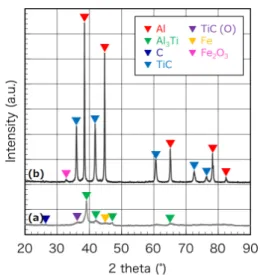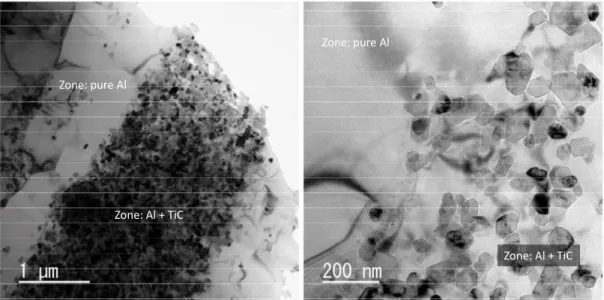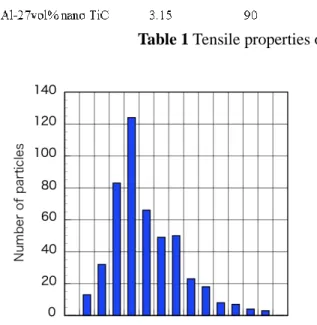HAL Id: cea-02491651
https://hal-cea.archives-ouvertes.fr/cea-02491651
Submitted on 26 Feb 2020HAL is a multi-disciplinary open access archive for the deposit and dissemination of sci-entific research documents, whether they are pub-lished or not. The documents may come from teaching and research institutions in France or abroad, or from public or private research centers.
L’archive ouverte pluridisciplinaire HAL, est destinée au dépôt et à la diffusion de documents scientifiques de niveau recherche, publiés ou non, émanant des établissements d’enseignement et de recherche français ou étrangers, des laboratoires publics ou privés.
followed by reactive sintering
H. Kurita, N. Samer, J. Andrieux, O. Dezellus, S. Gourdet, T. Miyazaki, O.
Martin, L. Chaffron
To cite this version:
H. Kurita, N. Samer, J. Andrieux, O. Dezellus, S. Gourdet, et al.. Nano titanium carbide particle reinforced aluminumcomposite materials prepared by ball milling followed by reactive sintering. 20th International Conference on Composite Materials, Jul 2015, Copenhague, Denmark. �cea-02491651�
NANO TITANIUM CARBIDE PARTICLE REINFORCED ALUMINUM
COMPOSITE MATERIALS PREPARED BY BALL MILLING
FOLLOWED BY REACTIVE SINTERING
Hiroki Kurita1, Nassim Samer2, Jérôme Andrieux2, Olivier Dezellus2, Sophie Gourdet3, Takamichi Miyazaki4, Olivier Martin5 and Laurent Chaffron1
1
DEN/DANS/DMN/SRMA/LTMEx, CEA Saclay, 91191 Gif sur Yvette, France Email: hiroki.kurita@cea.fr (H.Kurita), laurent.chaffron@cea.fr (L.Chaffron), web page:
http://www.cea.fr/
2
Laboratory of Multi-materials and Interfaces, University of Claude Bernard Lyon 1, 43, Bd du 11 Novembre 1918, 69622 Villeurbanne Cedex, France
Email: nassim.samer@univ-lyon1.fr (N.Samer), jerome.andrieux@univ-lyon1.fr (J.Andrieux), olivier.dezellus@univ-lyon1.fr (O.Dezellus), web page: http://www.univ-lyon1.fr/
3
Airbus Group Innovations, 12 rue Pasteur - BP 76, 92152 Suresnes, France Email: sophie.gourdet@airbus.com (S.Gourdet), web page: http://www.airbusgroup.com/
4
Technical Division, School of Engineering, Tohoku University, 6-6-11 Aoba Aramaki-aza, Aoba-ku, 980-8579 Sendai, Japan
Email: miyataka@m.tohoku.ac.jp (T.Miyazaki), web page: http://www.tohoku.ac.jp/
5
Mecachrome, Rue de Saint Règle - ZI de la Boitardière - CS 20300, 37400 Amboise, France Email: olivier.martin@fr.mecachrome.com (O.Martin), web page: http://www.mecachrome.com/
Keywords: Metal-matrix composites, Particle-reinforcement, Microstructures, Tensile properties
ABSTRACT
The development of the aviation industry requires the use of new metallic materials with superior specific mechanical properties compared to existing materials. In particular, the metal matrix composites (MMC) reinforced by nano-particles draw attention due to their excellent machinability. However, it is well-known that handling nanoparticles in industry is problematic due to respect of safety rules regarding nanomaterials. In order to overcome this problem, we have demonstrated the feasibility to fabricate nanocomposite materials without using any starting nanoparticles. We studied the ternary system aluminum/carbon/titanium for which we have shown the possibility to create the nanoparticles of titanium carbide by a flash sintering. So, we fabricated the titanium carbide (TiC) nano particles reinforced aluminum matrix (Al−nano TiC) composite, and demonstrated that the size
of TiC nanoparticles could be controlled by both heating rate and dwell temperature. We observed a very narrow size distribution of particles, ranging from 25 to 90 nm. Observation by transmission electron microscopy revealed that the TiC nanoparticles were individually distributed in Al−nano TiC composite and that the Al/nano TiC interface was intimate. Tensile tests have been performed on specimens with various TiC contents. It was found that the ultimate tensile strength of the Al−34 vol% nano TiC composite was higher than 600 MPa with a failure elongation of 4.2 %. The observed ridge of pure Al on the fracture surface implies that pure Al contributes to the conservation of a remarkable failure elongation of the Al−nano TiC composite. The elongation reaches 7.2 % with the TiC volume fraction of 27 %.
1. INTRODUCTION
The continuous growth in demand of transportation requires sophisticated structural materials demonstrating high mechanical properties, especially a high specific tensile strength, for the development of new generation aircrafts and automobiles. Aluminum (Al) is superior as a host material for superlight structural materials, not only because of its low density, but also due to its low price. Therefore, Al-based structural materials with high specific mechanical properties are interested for aerospace application. Al alloys are well known as Al-based structural materials. For example, Al2014−T6 (i.e. duralumin) with its light weight and remarkable mechanical responses is used in aerospace and automobile fields. However, the welding of Al alloys are extremely difficult because Al alloys are enhanced by the precipitation hardening based on the dislocation theory, via carefully controlled heat treatment (e.g. quenching, annealing).
Metal matrix composite (MMC) materials have been recognized for a long time as promising potential structural materials because they can satisfy both of high mechanical strengths and good elongation. The Al-based composite materials can be categorized into two main types; fiber reinforced Al matrix composites and particle reinforced Al matrix composites. Carbon-based fibers have been mainly considered for reinforcing the Al matrix, and multi-walled carbon nanotube could quite possibly be the perfect candidates for enhancing significantly the strength and stiffness of fiber reinforced Al matrix composites [1,2]. Fiber reinforced composites propose the high mechanical properties in a particular direction, although it paradoxically indicates that fiber reinforced composites have the anisotropic mechanical properties. On the other hand, particle reinforced Al-based composites have advantages in having isotropic mechanical properties and the secondary processing. Numerous materials, such as silicon carbide (SiC), titanium carbide (TiC), aluminum oxide (Al2O3),
boron nitride (BN), have been considered for reinforcing the Al matrix. Among them, TiC is the noteworthy reinforcement due to its thermal stability at the high temperature, and chemical stability in Al−Ti−C system.
The purpose of this study was the fabrication of titanium carbide nano particles reinforced aluminum matrix (Al−nano TiC) composite without nano titanium carbide particles as a starting material. This way of Al−nano TiC composite, without nano titanium carbide particles, contributes to reduce the risk of health hazard attributed to nano powder for the employees who work in factories. We investigate the tensile strength of this Al−nano TiC composite with two different TiC nano particles volume fractions, and discuss the results and the fracture mechanism with the use of transmission electron microscopy (TEM) micrographs.
2. EXPERIMENTAL PROCEDURE
Titanium tri-aluminide (Al3Ti) powder (Goodfellow, 99.5 % purity) graphite powders (Carbone
controlled to obtain the TiC nano particles of 34 vol% in the final Al−nano TiC composite. For comparison of mechanical properties, it was alongside prepared the mixed powder of Al3Ti, graphite
and pure Al powder (Goodfellow, 99.9 % purity), to obtain the TiC nano particles of 27 vol% in the final Al−nano TiC composite [3].
The mixed powders were ball milled by using a horizontal attritor (CM01, Zoz GmbH) for 15 hours under helium gas (99.99999 % purity) with 100C6 balls with the diameter of 5 mm. The temperature during a high energy-ball milling was monitored by two K-type thermocouples in direct contact with the mixing container and the exterior of a horizontal attritor. From this point forward, the sample preparation was carried out in the glove box under argon gas to prevent oxidation until the heat treatment step. The ball-milled powders with the particle size of 32 ~ 315 µm were employed after passing through sieves. The obtained ball-milled powders were vacuum-encapsulated in a rubber tube for 3 hours, and pressed by cold isostatic press (CIP) under 3000 bars for 1 min. The compacted bulks were vacuum-encapsulated in a steel can. To synthesis TiC particles inside of the compacted bulks, the steel can was heat-treated at 1000 °C for 20 min to obtain the nano size TiC particles. The heat-treated Al−nano TiC composites were inserted in a copper can (outer diameter of 76 mm) after machining to obtain the diameter of 25 mm. After that, Al−nano TiC composites in a copper can were densified by the hot extrusion using a vertical hydraulic press. Hot extrusion was performed at 500 °C with a reduction rate of 12. The extruded Al−nano TiC composites were machined for removing copper can and tensile test.
The relative densities of Al−nano TiC composites were measured by the Archimedes principle. The phases of Al−nano TiC composites were identified by X-Ray diffraction (XRD; D8 Advance Brüker, Brüker Corporation, United States) before and after the heat treatment, using CuKα1-α2 radiations
(average λ = 1.54187 Å). The microstructures of Al−nano TiC composite were observed by a field emission scanning electrons microscope (FE-SEM; JSM-6500F, JEOL, Japan) and a high-resolution transmission electrons microscope (HR-TEM; HF-200EDX, Hitachi, Japan) equipped with selected area diffraction (SAD) patterns. The particle size distribution is investigated by using analysis Software (Soft Imaging System Gmbh,www.soft-imaging.net).
3. RESULTS AND DISCUSSION
3.1 Microstructure of the Al–nano TiC composites Figure 1 shows the XRD results of Al–TiC composite before and after the heat treatment. Before heat treatment (i.e. after a high energy ball milling), It was mainly observed the peaks of Al3Ti and C. This
result shows that the powders of Al3Ti and C were
homogenously mixed without the creation of TiC by a high energy ball milling. The small peak of Fe indicated that the broken pieces of Fe balls came to be mixed in the mixed powder of Al3Ti and C. After heat
treatment, the peaks of Al and TiC were appeared alongside the disappearance of peaks of Al3Ti and C.
This result clearly shows that Al3Ti and C were reacted
during the heat treatment and TiC was formed inside of composite.
The microstructures of Al–TiC composites were same between after a heat treatment and after hot
Figure 1 XRD results of Al–TiC
composite: (a) before heat treatment and (b) after heat treatment at 1000 °C for 20 min.
extrusion. Figure 2 shows SEM micrographs of the Al–TiC composites after a heat treatment at 1000 °C for 20 min. It was observed 2 different zones in Al–TiC composite, and EDX revealed that they are the zones of Al rich and Ti rich (see Fig. 2b and c). In the Al–TiC composites which was added pure Al powder (i.e. Al–27 vol% TiC composite), the larger zones of Al rich was observed in compared with Al–34 vol% TiC composite. The white particles were identified as Fe, the chips of steel ball which came to be mixed during a high-energy ball milling. Therefore, it was shown that TiC particles are not individually and uniformly dispersed in Al matrix in the microscopic sense although it seems that Al–TiC composite has homogeneous structure at macroscopic level.
Figure 3 shows TEM micrographs of the Al–TiC composites after a heat treatment at 1000 °C for 20 min. TEM observation revealed that there is no TiC particle in the zone of Al rich, i.e. this zone is pure Al. On the other hand, TiC particles were observed in Ti rich zone. Note that the TiC nano particles were individually and uniformly dispersed in this Ti rich zone. Thus, it was shown that Ti rich zone is the zone of Al + TiC. Moreover, Al/TiC interface is intimately contacted without interfacial chemical compound and TiC particles were highly crystalized. It seemed that the size of TiC particles was smaller than 100 nm, and it was actually ascertained that the TiC particles have the diameter between 25 and 90 nm, by analysis software (see Figure 4).
Ti Al 10µm
a
b
c
Al rich Ti richFigure 2 SEM micrographs of the Al–TiC composites after a heat treatment at 1000 °C for 20 min.
Zone: pure Al
Zone: Al + TiC
Zone: pure Al
Zone: Al + TiC
3.2 Tensile strength of Al–nano TiC composites
The tensile properties of Al–TiC composites are shown on Table 1. Tensile strength of composite can be increased with TiC nano particles content. The average of ultimate tensile strengths of Al–34 vol% nano TiC and Al–27 vol% nano TiC composites were 628 MPa and 483 MPa respectively. The specific tensile strength of Al–34 vol% nano TiC composite is 194 N·m/kg, this value is even equal to structural Al alloys. Nevertheless, Al–TiC composites demonstrated the outstanding elongation to failure, (e.g. 7.2% with TiC nano particles of 27 vol%).
To understand this characteristic tensile behavior, it was observed the fracture surface of Al–nano TiC composites after tensile test. The dimples were observed on the fracture surface of Al–nano TiC composites; i.e. it was revealed that Al–TiC composite was fractured via a ductile failure (see Figure 5). It was demonstrated that Al–nano TiC composite, with TiC nano particles more than 30vol%, is fractured via a ductile mode of failure, while the ductile failure of Al–TiC composite has been reported with smaller quantity of TiC (5 ~ 22.3 vol%) [4,5]. Also, it was observed no TiC agglomeration on the fracture surface of Al–nano TiC composites. This result corroborated that TiC nano particles were individually and uniformly dispersed in the zone of Al + TiC. Furthermore, the observed ridge of pure Al on the fracture surface implies that pure Al contributes to the conservation of a remarkable failure elongation of the Al–nano TiC composite.
4. CONCLUSION
We fabricated Al-nano TiC composite via a high-energy ball milling followed by a reactive heat treatment without the use of nanometric powders as a starting material. Owing to the reactive heat treatment in very short time, we obtained a very narrow size distribution of TiC nano particles, ranging from 25 to 90 nm. TEM observation revealed that Al–nano TiC composite has a two-phase
10µm Figure 5 SEM micrographs of the
fracture surface of Al–TiC composites after tensile test.
Figure 4 TiC particle size distribution after the
heat treatment at 1000°C, for 16 min.
microstructure, the zones of pure Al and Al + TiC. TiC nano particles were individually and uniformly dispersed in Al matrix. Tensile strength of composite can be increased with TiC nano particles content with the outstanding elongation to failure. This characteristic elongation to failure is attributed to a ductile failure of Al–nano TiC composite. The average of ultimate tensile strength of Al–34 vol% nano TiC composite was 628 MPa. The specific tensile strength of Al–34 vol% nano TiC composite is even equal to structural Al alloys (194N·m/kg).
REFERENCES
[1] H. Kurita, E. Mehdi, H. Kwon, T. Miyazaki, W. Zhou, J.-F. Silvain, A. Kawasaki, Load-bearing contribution of multi-walled carbon nanotubes on tensile response of aluminum, Composites Part
A, 68, 2015, pp. 133-139.
[2] H. Kurita, H. Kwon, M. Estili, A. Kawasaki. Multi-walled carbon nanotube-aluminum matrix composites prepared by combination of hetero-agglomeration method, spark plasma sintering and hot extrusion. Materials. Transactions, 52(10), 2011, pp. 1960-1965.
[3] L. Chaffron, D. Nunes, Patent FR1350249, Procédé d’élaboration d’un matériau nanocomposite Al/TiC
[4] X.C. Tong, H.S. Fang, Al–TiC composites in situ–processed by ingot metallurgy and rapid solidification technology: Part II – Mechanical behavior, Metallurgical and Materials
Transactions A: Physical Metallurgy and Materials Science, 29, 1998, pp.893-902.
[5] N. Samer, J. Andrieux, B. Gardiola, N. Karnatak, O. Martin, H. Kurita, L. Chaffron, S. Gourdet, S. Lay, O. Dezellus, Microstructure and mechanical properties of an Al–TiC metal matrix composite obtained by reactive synthesis, Composites Part A, 72, 2015, pp. 50-57.


